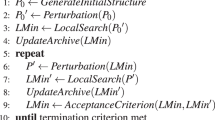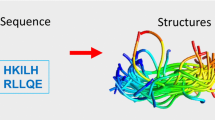Abstract
A method for generating protein backbone models from backbone only NMR data is presented, which is based on molecular fragment replacement (MFR). In a first step, the PDB database is mined for homologous peptide fragments using experimental backbone-only data i.e. backbone chemical shifts (CS) and residual dipolar couplings (RDC). Second, this fragment library is refined against the experimental restraints. Finally, the fragments are assembled into a protein backbone fold using a rigid body docking algorithm using the RDCs as restraints. For improved performance, backbone nuclear Overhauser effects (NOEs) may be included at that stage. Compared to previous implementations of MFR-derived structure determination protocols this model-building algorithm offers improved stability and reliability. Furthermore, relative to CS-ROSETTA based methods, it provides faster performance and straightforward implementation with the option to easily include further types of restraints and additional energy terms.




Similar content being viewed by others
References
Al-Hashimi HM, Valafar H, Terrell M, Zartler ER, Eidsness MK, Prestegard JH (2000) Variation of molecular alignment as a means of resolving orientational ambiguities in protein structures from dipolar couplings. J Magn Reson 143(2):402–406
Andrec M, Du P, Levy RM (2001) Protein backbone structure determination using only residual dipolar couplings from one ordering medium. J Biomol NMR 21(4):335–347
Banci L, Bertini I, Cavallaro G, Giachetti A, Luchinat C, Parigi G (2004) Paramagnetism-based restraints for Xplor-NIH. J Biomol NMR 28(3):249–261
Bax A, Cornilescu G, Hu JS (1999) Identification of the hydrogen bonding network in a protein by scalar couplings. J Am Chem Soc 121(12):2949–2950
Bax A, Delaglio F, Kontaxis G (2000) Protein structure determination using molecular fragment replacement and NMR dipolar couplings. J Am Chem Soc 122(9):2142–2143
Bax A, Kontaxis G, Tjandra N (2001) Dipolar couplings in macromolecular structure determination. Methods Enzymol 339:127–174
Berardi MJ, Shih WM, Harrison SC, Chou JJ (2011) Mitochondrial uncoupling protein 2 structure determined by NMR molecular fragment searching. Nature 476(7358):109–113
Bouvignies G, Markwick P, Bruschweiler R, Blackledge M (2006a) Simultaneous determination of protein backbone structure and dynamics from residual dipolar couplings. J Am Chem Soc 128(47):15100–15101
Bouvignies G, Meier S, Grzesiek S, Blackledge M (2006b) Ultrahigh-resolution backbone structure of perdeuterated protein GB1 using residual dipolar couplings from two alignment media. Angew Chem Int Ed Engl 45(48):8166–8169
Bouvignies G, Markwick PR, Blackledge M (2007) Simultaneous definition of high resolution protein structure and backbone conformational dynamics using NMR residual dipolar couplings. ChemPhysChem 8(13):1901–1909
Bowers PM, Strauss CE, Baker D (2000) De novo protein structure determination using sparse NMR data. J Biomol NMR 18(4):311–318
Cavalli A, Salvatella X, Dobson CM, Vendruscolo M (2007) Protein structure determination from NMR chemical shifts. Proc Natl Acad Sci USA 104(23):9615–9620
Chou JJ, Delaglio F, Bax A (2000a) Measurement of one-bond 15 N–13C’ dipolar couplings in medium sized proteins. J Biomol NMR 18(2):101–105
Chou JJ, Li S, Bax A (2000b) Study of conformational rearrangement and refinement of structural homology models by the use of heteronuclear dipolar couplings. J Biomol NMR 18(3):217–227
Clore GM (2000) Accurate and rapid docking of protein-protein complexes on the basis of intermolecular nuclear overhauser enhancement data and dipolar couplings by rigid body minimization. Proc Natl Acad Sci USA 97(16):9021–9025
Clore GM, Bewley CA (2002) Using conjoined rigid body/torsion angle simulated annealing to determine the relative orientation of covalently linked protein domains from dipolar couplings. J Magn Reson 154(2):329–335
Clore GM, Schwieters CD (2003) Docking of protein-protein complexes on the basis of highly ambiguous intermolecular distance restraints derived from 1H/15 N chemical shift mapping and backbone 15 N-1H residual dipolar couplings using conjoined rigid body/torsion angle dynamics. J Am Chem Soc 125(10):2902–2912
Clore GM, Kuszewski J, Gronenborn AM (1999) Improving the packing and accuracy of NMR structures with a pseudopotential for the radius of gyration. J Am Chem Soc 121(10):2337–2338
Cordier F, Grzesiek S (1999) Direct observation of hydrogen bonds in proteins by interresidue (3 h) J (NC ‘) scalar couplings. J Am Chem Soc 121(7):1601–1602
Delaglio F, Grzesiek S, Vuister GW, Zhu G, Pfeifer J, Bax A (1995) NMRPipe: a multidimensional spectral processing system based on UNIX pipes. J Biomol NMR 6(3):277–293
Giesen AW, Homans SW, Brown JM (2003) Determination of protein global folds using backbone residual dipolar coupling and long-range NOE restraints. J Biomol NMR 25(1):63–71
Hus JC, Marion D, Blackledge M (2001) Determination of protein backbone structure using only residual dipolar couplings. J Am Chem Soc 123(7):1541–1542
Jaroniec CP, Ulmer TS, Bax A (2004) Quantitative J correlation methods for the accurate measurement of 13C’-13Calpha dipolar couplings in proteins. J Biomol NMR 30(2):181–194
Kontaxis G, Delaglio F, Bax A (2005) Molecular fragment replacement approach to protein structure determination by chemical shift and dipolar homology database mining. Methods Enzymol 394:42–78
Koradi R, Billeter M, Wuthrich K (1996) MOLMOL: a program for display and analysis of macromolecular structures. J Mol Graph 14(1):51–55 29–32
Kraulis PJ (1991) Molscript: a program to produce both detailed and schematic plots of protein structures. J Appl Crystallogr 24:946–950
Kuszewski J, Clore GM (2000) Sources of and solutions to problems in the refinement of protein NMR structures against torsion angle potentials of mean force. J Magn Reson 146(2):249–254
Kuszewski J, Gronenborn AM, Clore GM (1996) Improving the quality of NMR and crystallographic protein structures by means of a conformational database potential derived from structure databases. Protein Sci 5(6):1067–1080
Kuszewski J, Gronenborn AM, Clore GM (1997) Improvements and extensions in the conformational database potential for the refinement of NMR and X-ray structures of proteins and nucleic acids. J Magn Reson 125(1):171–177
Leaver-Fay A, Tyka M, Lewis SM, Lange OF, Thompson J, Jacak R, Kaufman K, Renfrew PD, Smith CA, Sheffler W, Davis IW, Cooper S, Treuille A, Mandell DJ, Richter F, Ban YE, Fleishman SJ, Corn JE, Kim DE, Lyskov S, Berrondo M, Mentzer S, Popovic Z, Havranek JJ, Karanicolas J, Das R, Meiler J, Kortemme T, Gray JJ, Kuhlman B, Baker D, Bradley P (2011) ROSETTA3: an object-oriented software suite for the simulation and design of macromolecules. Methods Enzymol 487:545–574
Losonczi JA, Andrec M, Fischer MW, Prestegard JH (1999) Order matrix analysis of residual dipolar couplings using singular value decomposition. J Magn Reson 138(2):334–342
Meiler J, Baker D (2003) Rapid protein fold determination using unassigned NMR data. Proc Natl Acad Sci USA 100(26):15404–15409
Merritt EA, Bacon DJ (1997) Raster3D: photorealistic molecular graphics. Methods Enzymol 277:505–524
Merritt EA, Murphy ME (1994) Raster3D Version 2. 0. A program for photorealistic molecular graphics. Acta Crystallogr D Biol Crystallogr 50(Pt 6):869–873
Ottiger M, Delaglio F, Bax A (1998a) Measurement of J and dipolar couplings from simplified two-dimensional NMR spectra. J Magn Reson 131(2):373–378
Ottiger M, Delaglio F, Marquardt JL, Tjandra N, Bax A (1998b) Measurement of dipolar couplings for methylene and methyl sites in weakly oriented macromolecules and their use in structure determination. J Magn Reson 134(2):365–369
Raman S, Lange OF, Rossi P, Tyka M, Wang X, Aramini J, Liu G, Ramelot TA, Eletsky A, Szyperski T, Kennedy MA, Prestegard J, Montelione GT, Baker D (2010) NMR structure determination for larger proteins using backbone-only data. Science 327(5968):1014–1018
Ramirez BE, Voloshin ON, Camerini-Otero RD, Bax A (2000) Solution structure of DinI provides insight into its mode of RecA inactivation. Protein Sci 9(11):2161–2169
Rasia RM, Lescop E, Palatnik JF, Boisbouvier J, Brutscher B (2011) Rapid measurement of residual dipolar couplings for fast fold elucidation of proteins. J Biomol NMR 51(3):369–378
Rohl CA, Baker D (2002) De novo determination of protein backbone structure from residual dipolar couplings using Rosetta. J Am Chem Soc 124(11):2723–2729
Rohl CA, Strauss CE, Misura KM, Baker D (2004) Protein structure prediction using Rosetta. Methods Enzymol 383:66–93
Sass J, Cordier F, Hoffmann A, Cousin A, Omichinski JG, Lowen H, Grzesiek S (1999) Purple membrane induced alignment of biological macromolecules in the magnetic field. J Am Chem Soc 121(10):2047–2055
Schwieters CD, Kuszewski JJ, Tjandra N, Clore GM (2003) The Xplor-NIH NMR molecular structure determination package. J Magn Reson 160(1):65–73
Shen Y, Lange O, Delaglio F, Rossi P, Aramini JM, Liu G, Eletsky A, Wu Y, Singarapu KK, Lemak A, Ignatchenko A, Arrowsmith CH, Szyperski T, Montelione GT, Baker D, Bax A (2008) Consistent blind protein structure generation from NMR chemical shift data. Proc Natl Acad Sci USA 105(12):4685–4690
Shen Y, Vernon R, Baker D, Bax A (2009) De novo protein structure generation from incomplete chemical shift assignments. J Biomol NMR 43(2):63–78
Shen Y, Bryan PN, He Y, Orban J, Baker D, Bax A (2010) De novo structure generation using chemical shifts for proteins with high-sequence identity but different folds. Protein Sci 19(2):349–356
Simons KT, Bonneau R, Ruczinski I, Baker D (1999) Ab initio protein structure prediction of CASP III targets using ROSETTA. Proteins Suppl 3:171–176
Walsh JD, Wang YX (2005) Periodicity, planarity, residual dipolar coupling, and structures. J Magn Reson 174(1):152–162
Walsh JD, Kuszweski J, Wang YX (2005) Determining a helical protein structure using peptide pixels. J Magn Reson 177(1):155–159
Wang J, Walsh JD, Kuszewski J, Wang YX (2007) Periodicity, planarity, and pixel (3P): a program using the intrinsic residual dipolar coupling periodicity-to-peptide plane correlation and phi/psi angles to derive protein backbone structures. J Magn Reson 189(1):90–103
Wu Z, Delaglio F, Wyatt K, Wistow G, Bax A (2005) Solution structure of (gamma)S-crystallin by molecular fragment replacement NMR. Protein Sci 14(12):3101–3114
Author information
Authors and Affiliations
Corresponding author
Electronic supplementary material
Below is the link to the electronic supplementary material.
Rights and permissions
About this article
Cite this article
Kontaxis, G. An improved algorithm for MFR fragment assembly. J Biomol NMR 53, 149–159 (2012). https://doi.org/10.1007/s10858-012-9632-7
Received:
Accepted:
Published:
Issue Date:
DOI: https://doi.org/10.1007/s10858-012-9632-7




